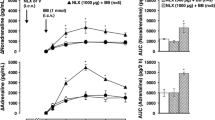Abstract
In rats under a mild stress of restraint the interaction between central opioid receptors and histaminergic stimulation of the pituitary-adrenocortical activity was investigated indirectly through corticosterone secretion. In order to avoid a possible direct action on adrenal glands, all the tested drugs were administered intracerebroventricularly (icv). Naloxone an opioid antagonist and cimetidine, a H2- and mepyramine a H1-receptor antagonists were given 15 min before histamine and histamine agonists. One hour after histaminergic drug injection the rats were restrained for 10 min and decapitated. Histamine, 2-pyridylethylamine (PEA), a histamine H1-receptor agonist, and 4-methylhistamine (MeHA) and dimaprit, H2-receptor agonists, significantly intensified the stress-induced increase in serum corticosterone levels. Naloxone, given alone icv or ip, did not substantially alter the stress-induced corticosterone response. Like mepyramine naloxone abolished the corticosterone response to PEA in stressed rats. Naloxone also decreased significantly, though not totally, the corticosterone response to MeHA, dimaprit and histamine, its efficiency being similar to that of cimetidine, a H2-receptor antagonist. These results suggest that in stressed rats central opioid receptors are considerably involved in the histamine H1-receptor — and, to a lesser degree, in the H2-recepor stimulation of the hypothalamo-pituitary-adrenocortical axis.
Similar content being viewed by others
References
J. Bugajski and Z. Janusz,Central histaminergic stimulation of pituitary-adrenocortical response in the rat. Life Sci.33, 1179–1180 (1983)
J. Bugajski and A. Gadek,Central H 1- and H 2 -histaminergic stimulation of pituitary-adrenocortical response under stress in rats. Neuroendocrinology36, 424–430 (1983).
A. Pfeiffer and A. Herz,Endocrine actions of opioids. Horm. Metabol. Res.16, 386–397 (1984).
S. Suemaru, K. Hashimoto and Z. Ota,Effects of morphine on hypothalamic corticotropin-releasing factor (CRF), norepinephrine and dopamine in non-stressed and stressed rats. Acta Med. Okayama39, 463–470 (1985).
A. Gadek-Michalska and J. Bugajski, Naloxone antagonizes a central histaminergic stimulation of corticosterone secretion in rats. Agents and Actions 23, 390–393 (1988).
L. Eroglu,Effect of morphine on the brain histamine levels in stress-exposed rats. Psychopharmacology63, 13–15 (1979).
M. Nishibori, R. Oishi, Y. Itoh and K. Saeki,Morphine-induced changes in histamine dynamics in mouse brain. Journal of Neurochemistry45, 719–724 (1985).
A. Gadek-Michalska, J. Bugajski and B. Cetera,Involvement of central opioid and adrenergic receptors in corticosterone response to met-enkephalinamide in rats under stress. InStress: The role of Catecholamines and Other Neurotransmitters. (Eds.E. Usdin, R. Kvetnansky andJ. Axelrod)Gordon and Breach Science Publishers, New York 1989.
M. Tanaka, Y. Kohno, R. Nakagawa, Y. Ida, K. Iimori, Y. Hoaki, A. Tsuda and N. Nagasaki,Naloxone enhances stress-induced increases in noradrenaline turnover in specific brain regions in rats. Life Sci.30, 1663–1669 (1982).
R. M. Eisenberg,Effects of naloxone on plasma corticosterone in the opiate-naive rat. Life Sci.26, 935–943 (1980).
D. Jezova, J. Jurcovicova, M. Vigas and F. Labrie,Possible mechanisms involved in naloxone-, morphine- and stress-induced ACTH release in rats. InStress: The Role of Catecholamines and Other Neurotransmitters. (Eds. E. Usdin, R. Kvetansky and J. Axelrod) Gordon and Breach Science Publishers, New York 1984.
J. R. Lymangrover, L. A. Dokas, A. Kong, R. Martin and M. Saffran,Naloxone has a direct effect on the adrenal cortex. Endocrinology109, 1132–1137 (1981).
V. Coiro, P. Chiodera, R. Volpi, G. Salati, P. Ferrari, A. Caiazza and G. Rossi,Histaminergic H 1 and H 2 receptors do not mediate cortisol release in response to naloxone in normal men. Biomed. Pharmacother.38, 358–360 (1984).
P. Chiodera, R. Volpi, R. Delsignore, L. Ippolito, G. Rossi, L. Camellini, C. Marchesi, A. Gnudi and V. Coiro,Muscarinic cholinergic and histaminergic H 1 and H 2 receptors are not involved in the LH response to naloxone in man. Hormones Res.25, 120–124 (1987).
R. C. A. Fredericson,Peptide receptors in the brain. InThe Endocrine Functions of the Brain. (Ed. M. Motta) pp. 233–270, Raven Press, New York 1980.
K. E. Moore and C. A. Johnston,The median eminence: aminergic control mechanisms. InNeuroendocrine Perspectives, vol. 1, (Eds. E. E. Müller and R. M. MacLeod) pp 23–68, Elsevier Biomediacal Press, 1982.
Zs. Liposits, C. Phelix and W. K. Paull,Adrenergic innervation of corticotropin releasing factor (CRF)-synthesizing neurons in the hypothalamic paraventricular nucleus of the rat. Histochemistry84, 201–205 (1986).
Zs. Liposits, C. Phelix and W. K. Paull,Synaptic interaction of serotonergic axons and corticotropin releasing factor (CRF) synthesizing neurons in the hypothalamic paraventricular nucleus of the rat. A light and electron microscopic immunocytochemical study. Histochemistry86, 541–549 (1987).
A. Gadek and J. Bugajski,The effect of adrenergic and cholinergic antagonists on central histaminergic stimulation of pituitary-adrenocortical response under stress in rats. Neuroendocrinology38, 447–452 (1984).
Y. Nakai, S. Shioda, H. Ochiai and K. Kozasa,Catecholamine-peptide interactions in the hypothalamus. InCurrent Topics in Neuroendocrinology, vol. 7, pp. 135–160, 1986.
A. N. M. Schoffelmeer, E. A. Wierenga and A. H. Mulder,Role of adenylate cyclase in presynaptic α 2 -adrenoceptors and μ-opioid receptor-mediated inhibition of 3 H noradrenaline release from rat brain cortex slices. J. Neurochem.46, 1711–1717 (1986).
A. H. Mulder, F. Hogenboom, G. Wardeh and A. N. M. Schoffelmeer,Morphine and enkephalins potently inhibit 3 H noradrenaline release from rat brain cortex synaptosomes: Further Evidence for a presynaptic localization of μ-opioid receptors. J. Neurochem.48, 1043–1047 (1987).
N. Limberger, L. Späth, Th. Hölting and K. Starke,Mutual interaction between presynaptic α 2 -adrenoceptors and opioid κ-receptors at the noradrenergic axons of rabbit brain cortex. Naunyn-Schmiedeberg's Arch. Pharmacol.334, 166–171 (1986).
Author information
Authors and Affiliations
Rights and permissions
About this article
Cite this article
Gądek-Michalska, A., Bugajski, J. Antagonistic action of naloxone on central histamine receptors-stimulated corticosterone secretion in rats under stress. Agents and Actions 28, 159–163 (1989). https://doi.org/10.1007/BF01967395
Received:
Accepted:
Issue Date:
DOI: https://doi.org/10.1007/BF01967395



